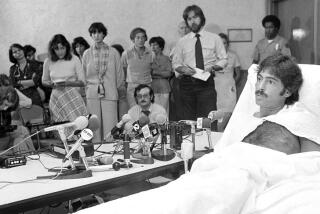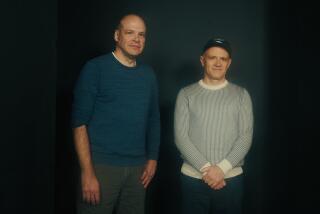Grover Krantz, 70; Bigfoot Researcher
- Share via
Over the years, Grover Krantz would sometimes climb into his car at night and go for long, lonely rides into the woods of the Pacific Northwest. Creeping along the back roads at 25 mph with a rifle and spotlight at his side, he desperately hoped his elusive quarry, a sasquatch, would show itself.
But it never did. Not once in more than 30 years of looking.
Krantz, considered one of the world’s foremost authorities on the supposed apelike denizen of the Northwest’s forests, died Feb. 14 of pancreatic cancer in Port Angeles, Wash. He was 70.
Krantz was unique because of his credentials. A longtime physical anthropologist at Washington State University in Pullman, he approached Bigfoot not as a joke but as a scientific problem that needed to be solved--even if it meant shooting one down.
What perplexed and even maddened colleagues but delighted Bigfoot enthusiasts was that Krantz was a legitimate academic.
He was a respected lecturer and expert on human evolution, with dozens of peer-reviewed papers to his credit, as well as a book titled “Big Footprints: A Scientific Inquiry into the Reality of Sasquatch.”
“I think the more criticism he got on [Bigfoot], the harder he dug in his heels,” said Don Tyler, a former student of Krantz’s and the head of the anthropology department at the University of Idaho.
“He thought he was approaching this thing in the correct way, as a scientific problem. But many professors considered it a topic that was not appropriate to be studied.”
Krantz was born in 1931 in Salt Lake City, and as a child became fascinated with the skeletal remains of animals he found. His interests led him to the field of anthropology, a subject he began teaching at Washington State in 1968.
Although Krantz had heard the story of Bigfoot as a teenager, he remained skeptical until he was called in 1970 to look at alleged Bigfoot tracks in northeast Washington. Expecting to find an obvious hoax, Krantz thought the footprints were too sophisticated to be fake because one of the feet showed a crippling bone injury.
As the years passed, Krantz interviewed hundreds of people who said they had encountered a Bigfoot in the region. He also did a frame-by-frame analysis of the famous short film, allegedly of a Bigfoot, made by Roger Patterson in 1967 in Northern California.
Krantz thought the images were legitimate. Others thought they were the product of an uninspired stunt featuring a man in a monkey suit.
Using casts of footprints, films, witness encounters and his knowledge of human evolution, Krantz developed an elaborate natural history of the sasquatch.
In his view, there were about 2,000 still living in North America. An adult male stood about 8 feet, weighed 800 pounds and had feet twice the size of a human foot. They had probably migrated over the Bering Land Strait to the continent. They were nocturnal and shy. As with bears, their diets consisted of carrion, berries and vegetation.
When asked by a magazine writer why sasquatch remains were never found, Krantz replied:
“Well, that’s the annoying part. Although we found jaws and teeth in China from what I guess to be sasquatch’s ancestor, we have nothing in North America. But this is probably because, first, it’s a rare animal and, second, it has no natural predators, so they die slowly and creep off and hide. Bears do this. Practically the only bear specimens we have in museums had to be shot by somebody.”
Krantz, not surprisingly, was eagerly sought by reporters because of his willingness to talk on the record about a creature more apt to be seen in the National Enquirer than National Geographic.
In recent years, he was frequently quoted as being an avid supporter of shooting a Bigfoot--he felt a body was needed to prove sasquatch was real. Besides the usual trouble such talk stirred up at Washington State, even local environmentalists took umbrage at Krantz for advocating the killing of what was presumably an endangered species.
Bill Lipe, a professor emeritus of anthropology at Washington State, was a longtime colleague of Krantz’s.
“He was a person who liked to take on controversial issues in his own field of physical anthropology, and he was willing to look at things that other people in his field wouldn’t look at,” said Lipe. “He wrote an early paper on the influence of language on human evolution that was way ahead of its time. He said he liked to take on an underdog hypothesis and make it credible, and, of course, the sasquatch hypothesis is an underdog.”
Although his sasquatch work was largely dismissed by academics, Krantz was embraced by those who believed in Bigfoot and others who simply liked the idea that such a large species could persist in the modern world.
This was particularly true in Willow Creek, a tiny village in the Trinity Alps range of Northern California. The Patterson film was apparently shot nearby, and the town has a Bigfoot museum and an annual Bigfoot festival.
Al Hodgson, 78, has lived in the area since 1933 and works at the museum. He says Krantz’s legacy is the ability to cast aside preconceived notions and believe in something that so many find unbelievable.
“I know about a dozen people who have seen a Bigfoot up here but are so afraid they’re going to be laughed at they don’t do anything,” Hodgson said. “But Grover and others really helped legitimize Bigfoot, while the people who tried to do otherwise have really failed miserably.”
Krantz is survived by his wife, Diane Horton, and a stepson.
More to Read
Sign up for Essential California
The most important California stories and recommendations in your inbox every morning.
You may occasionally receive promotional content from the Los Angeles Times.













